Dog Sleeping In Bed? The Perks, The Pros & The Perils
Co-sleeping with dogs can have benefits (and downsides) for us and our furry friends. So here are 2 steps you can take to decide whether your dog sleeping in bed with you is a good idea.
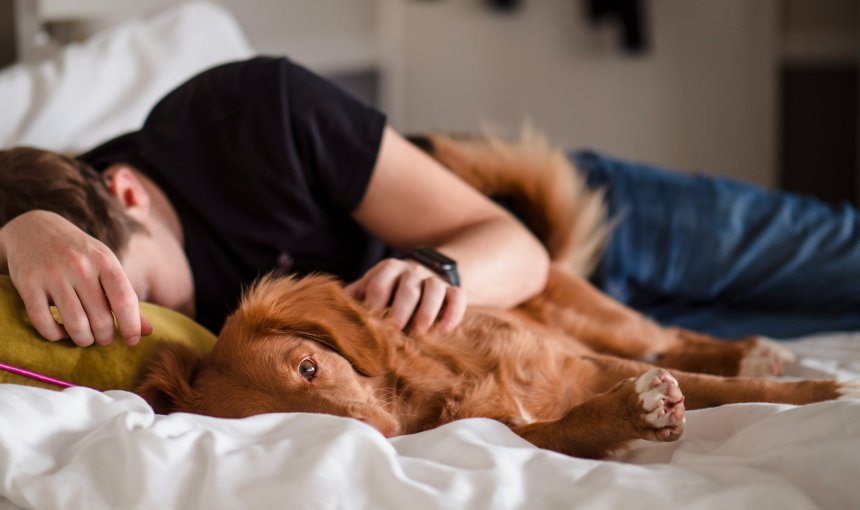
Fact: Your dog loves being close to their favorite human (that’s you). Also fact: You love snuggling up with your dog. But is it the best idea to have your dog sleeping in bed with you?
Now for some, that’s a no-no – but it’s possible they don’t have all the facts. That’s why we wanted to give you all the info you need – including the perks and perils of sleeping with dogs – so you can decide whether letting your dog(s) sleep in bed is right for you.
(Hint: having your buddy nearby is one of the best ways you can ensure they’re getting enough sleep – including good-quality sleep. So you can more quickly intervene if you notice something out of the ordinary.)
Now without further ado, let’s get started!

Find out how your dog spends their time.
Read moreA brief history of (co-)sleeping with dogs
Sleeping together in bed with dogs (which you can call co-sleeping if you’re feeling fancy) may come naturally to you. And it’s no surprise – dogs and humans have been sleeping together for centuries, across cultures1. It’s an ancient practice.
Back in the day, domesticated dogs would share sleeping quarters with their early human guardians. And in return, protect and alert them to predators or danger. Plus, they helped us keep warm at night in a time when home heating options were…. limited. Over the centuries, this human-dog bond helped humans (and dogs) survive through difficult times, including cold weather2.
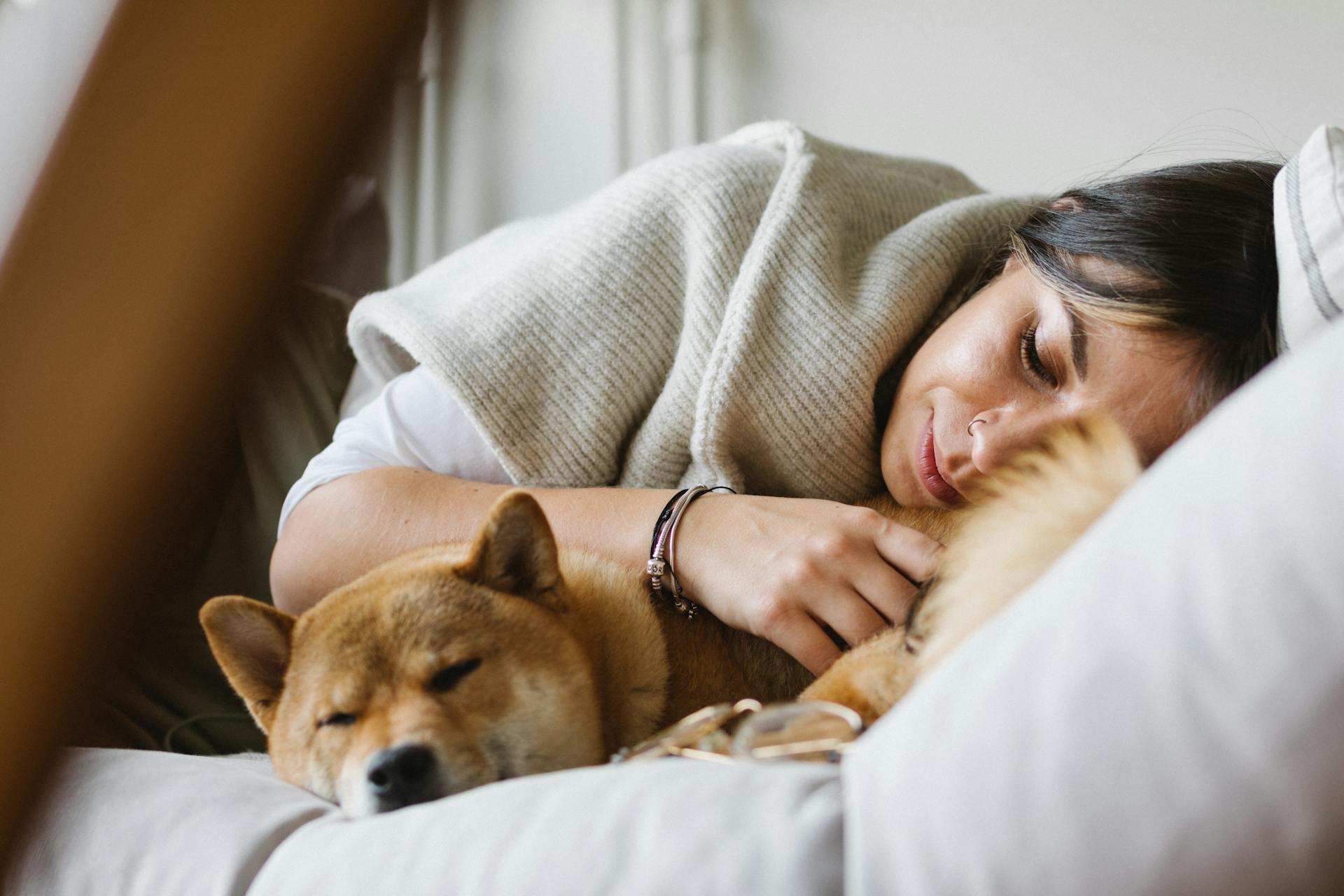
Some anthropologists even think the urge to sleep close to one another (both for dogs and humans) might actually be stored in our DNA2. Just imagine a toddler cuddling and dozing off with a four-legged friend – it happens almost automatically.
In short, there’s nothing more natural than wanting to curl up with your pup.
But before you start shopping for dog-friendly blankets, let’s take a look at both the benefits and downsides of of letting your dog sleep in bed with you.

Where a dog sleeping in bed can be a great idea
Sharing your bed with your dog can be good for you, despite what your friends say. And you would be far from alone – one American Kennel Club study found that 45% of people welcome their dog into their bed3.
Here are just some of the benefits of sleeping with your dog:
- Cold feet? Not anymore, with a doggo curled up next to your toes. Remember, sleeping with a dog can help us stay warm at night.
- Feeling anxious? Sharing the bed with your dog can have a calming effect.
- Want to feel that fuzzy feeling? Co-sleeping boosts oxytocin (a.k.a. “the love hormone”) which strengthens the bond between you and your dog.
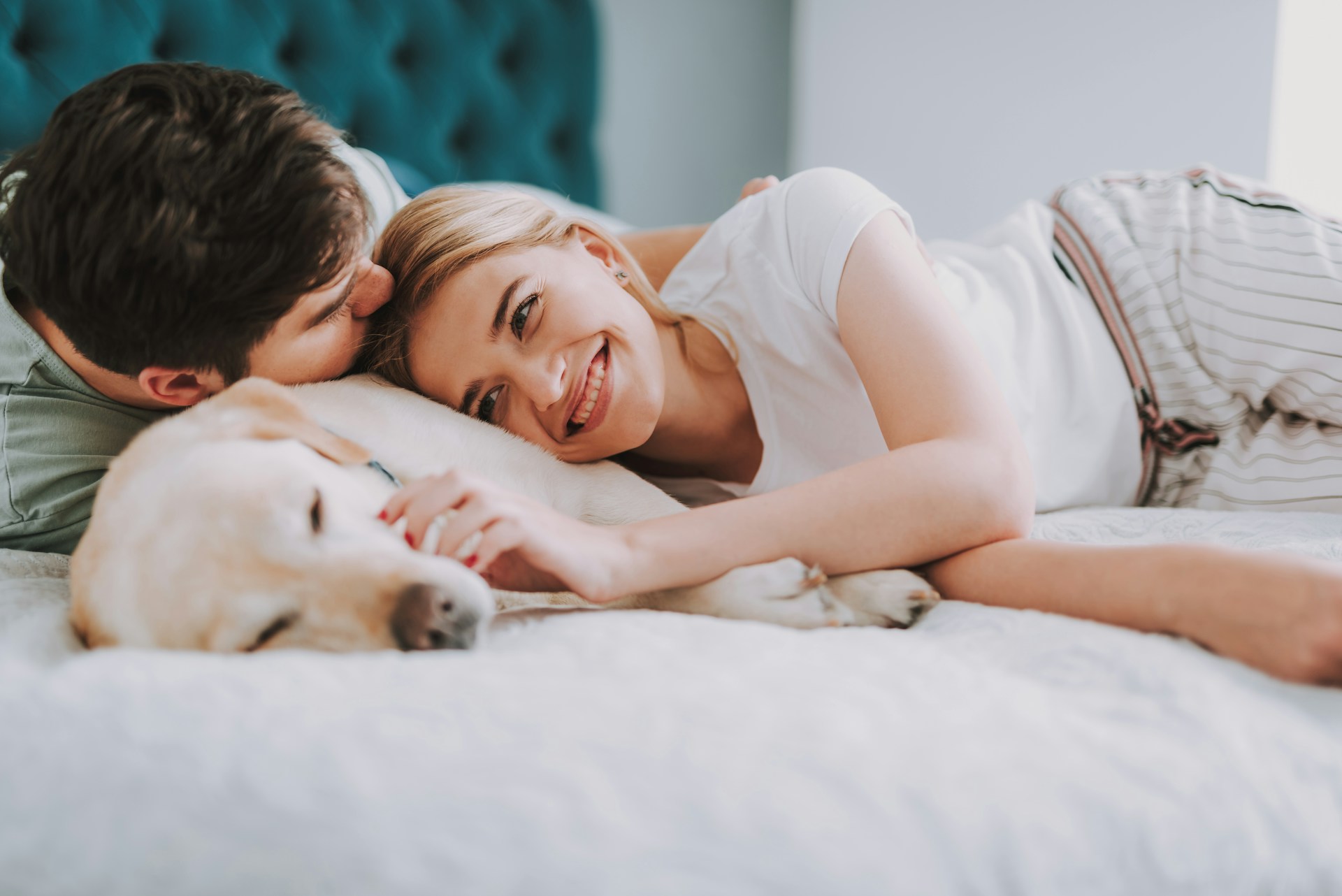
- Feeling uneasy? Sleeping with your dog can help you feel more secure. Plus, they can alert you if they sense something out of the usual.
- Still need convincing? You get to wake up every day with your best friend.
Just watch out: once you invite your dog to your bed, it might not be easy to take back that invitation. You’ll also want to teach your dog where to sleep in the bed, so that you can both be comfortable.
But with all the benefits of having a dog, it’s no surprise that sleeping with your buddy can also have a positive impact on your well-being.
But it’s not always so simple. Below are some downsides to sleeping with your dog in bed, which might make you decide against it.
Where a dog sleeping in bed might be a not-so-great idea
It’s not all sunshine and smiles. In fact, sleeping with a dog can get messy. Here’s a few reasons why not to let your dog get in your bed:
- Your dog will likely bring hair, dirt, dust, and other allergens into bed with them. Not good if you have allergies. Letting your dog sleep in bed could also increase your exposure to zoonotic diseases or parasites, like ticks. Ick!
- They may interfere with your sleep cycle. Dogs have different sleep schedules, and might end up waking you up at odd hours. If you’re already a light sleeper, or have insomnia, sleeping with your dog may not be the best for you.
- Sick dogs, puppies, new dogs, or dogs who are not yet house trained yet are not the best candidates for sleeping in bed. You don’t want an unexpected wet surprise at 3 in the morning! (Find out how to get the stain out if your dog does pee on your mattress…)

- Some dogs may become territorial about their spot in the bed. Set clear boundaries around where you sleep, especially if your dog shows signs of aggression or dominance.
- If you or your dog have an open wound or illness, disease transmission could be a risk (although this is very rare).
- Like a small child, your furry friend could fall off the bed and injure themselves.
- Last but not least, your partner may not like having the dog in bed.
If any of these factors cool you off from the idea of sleeping with your dog, it might be best to choose another spot for your dog.
Where tracking your dog’s movements can come in handy
No matter whether your dog prefers the indoors or outdoors, staying on top of their wanderings is a smart idea. Why? Because if you know where they’re off exploring, you can take a call whether bathtime before bedtime is a good idea. (And whether you should be letting them into bed with you from a hygiene standpoint.)
For example, your dog might end up wandering off to:
- Your neighbor’s pesticide-riddled backyard
- Your local park, which is full of toxic substances like snail bait
- Your garage, which means both dust, mites, and substances they shouldn’t be ingesting
- Your local garbage dump, where they might end up dumpster diving
- Somewhere other pets might be hanging out (like a dog park) – where they might pick up an infectious virus
- Somewhere they might be injured by another pet, person, or predator
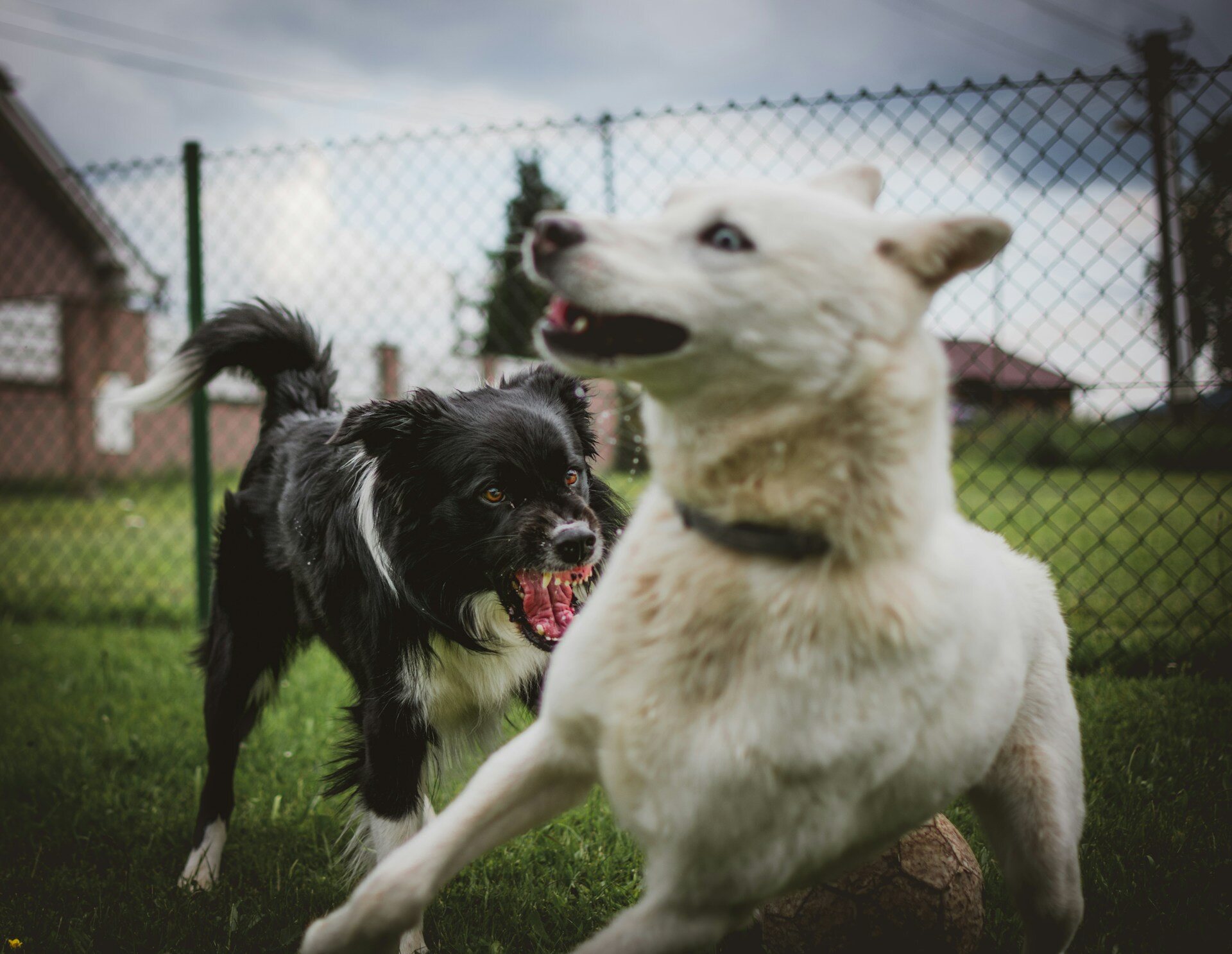
💡 So imagine being able to track your dog in real-time – no matter how far off they’re roaming?
- Or get an instant escape alert the minute they leave a “safe zone” – like your backyard?
- Or figure out their favorite hangout spots around your neighborhood? (Especially that pollen-riddled patch of woodland which they might be bringing home straight to your bedsheets?)
- Or even warn fellow pet parents about “danger zones” in your vicinity – like spots with mushrooms, poisonous plants, poison bait, animal traps, or wild animals?
All this – and more – are why dog parents around the world (just like you) are investing in Tractive’s lifesaving GPS tracking technology.
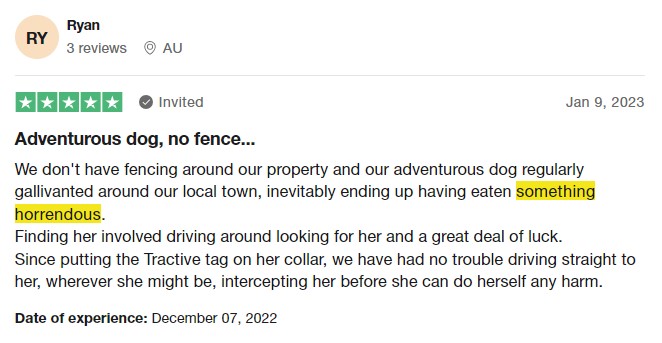
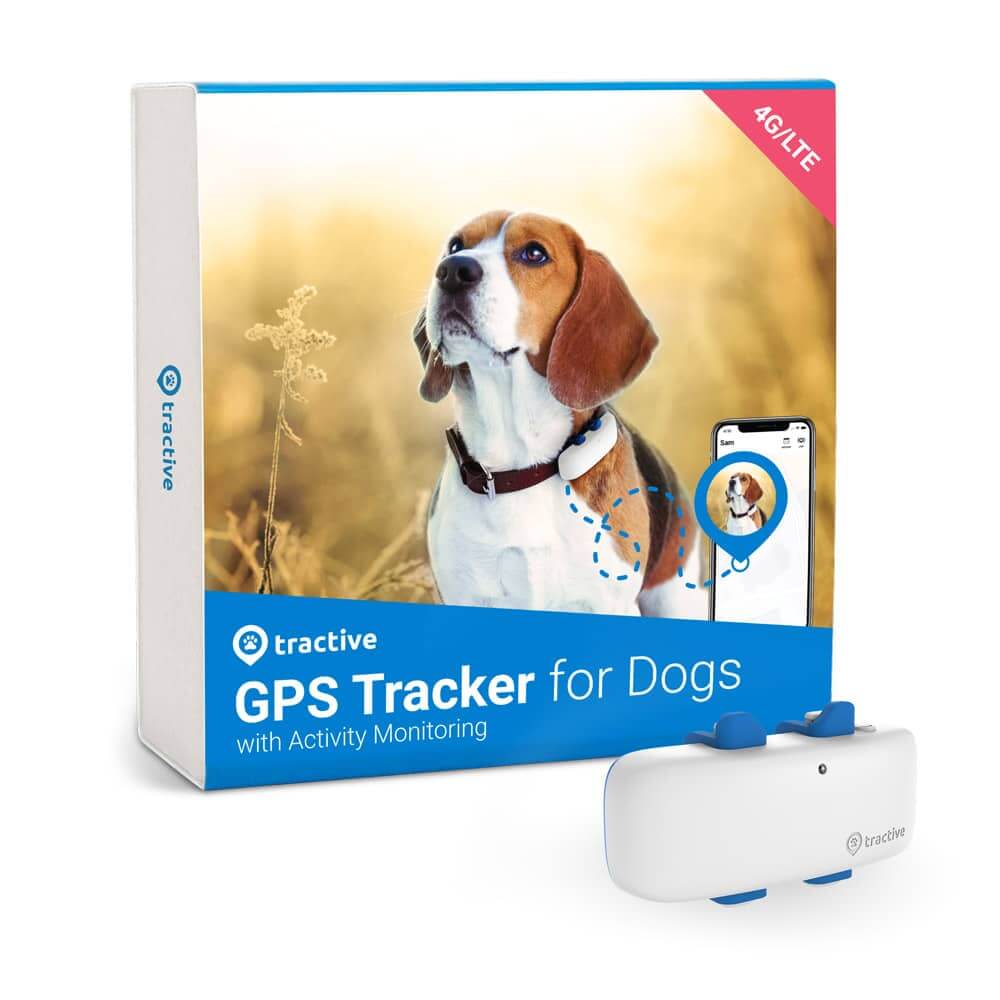
Always know where your dog is
Follow every step in real-time with unlimited range. Get alerts if they wander too far. Keep them happy & healthy with Wellness Monitoring. And let others – like walkers or sitters – keep an eye on your dog too.
💡Your dog might also be investigating every dusty nook and cranny of your indoor space – including crawlspaces, attics, basements and more.
So here are 3 quick and easy ways to locate your dog indoors with your Tractive device.
Why your dog wants to sleep in bed with you
It’s not just you who finds it nice to be close to your dog at night. Dogs love it too. As pack animals, dogs satisfy their instinct for safety and comfort by staying close to their pack mates. They may also feel the instinct to guard you at night.
Dogs are also instinctive cuddlers – snuggling up to you helps them releases oxytocin, the love hormone we mentioned earlier5.
- It’s especially important for dogs that suffer from separation anxiety, who calm themselves when they get to sleep in bed with you.
- In fact, the myth that separation anxiety or aggression in dogs is caused by co-sleeping is just that. A myth.
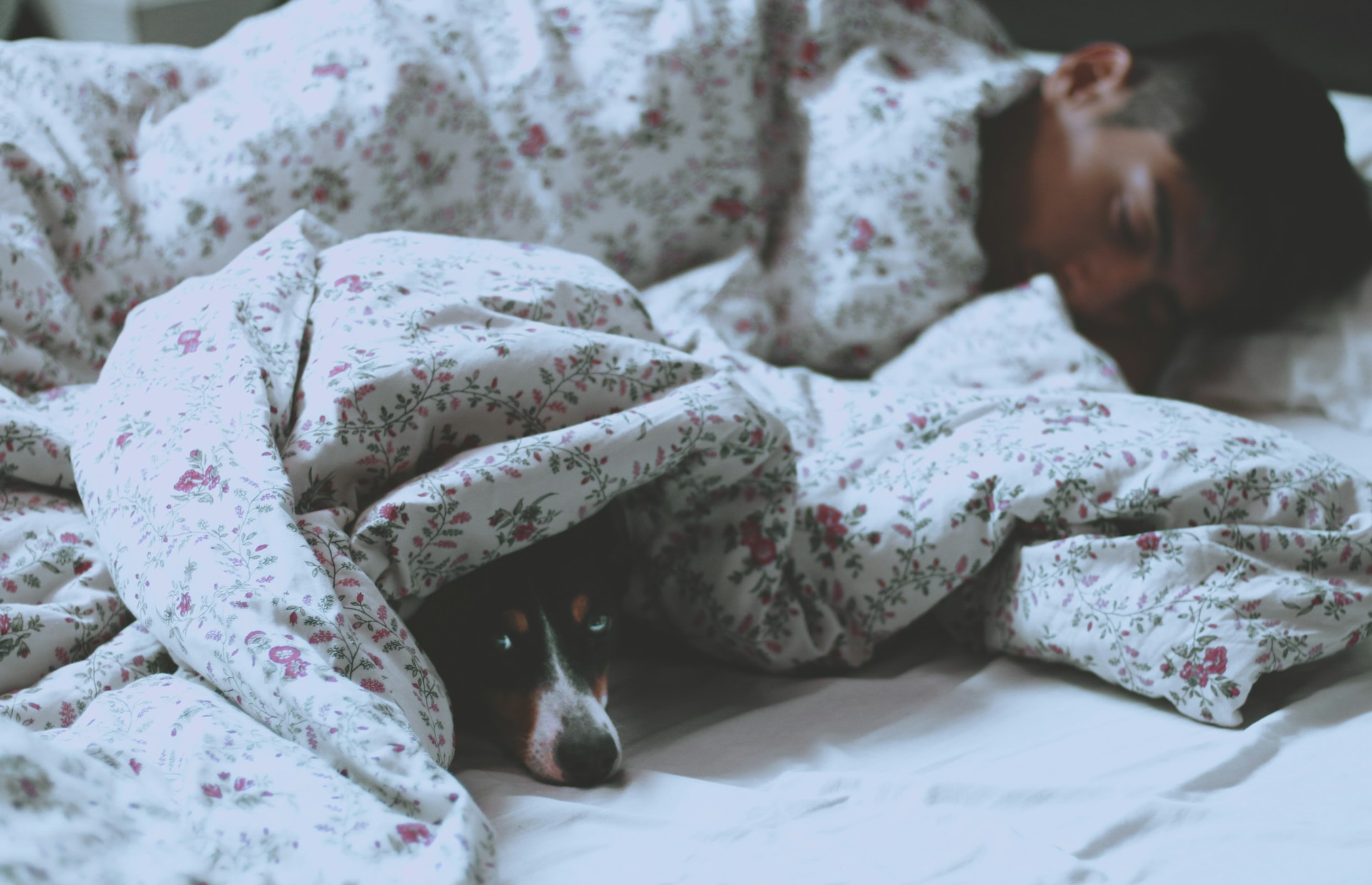
Where monitoring your dog’s sleep can come in handy
Now no matter whether you want your dog sleeping in bed with you or not – it’s important they get a good night’s rest.
Because with enough sleep (and high-quality sleep at that) – your dog stays happy and healthy for the long run.
- If you’re noticing them twitching in their sleep or waking up repeatedly, they might not be getting the sleep they need to stay healthy.
- Over time, a drop in your dog’s sleep quality can signal a major red flag for worse health issues down the line.
And the bad news? If your dog is consistently sleeping poorly…over time, you will too.
Plus, left untreated, sleeping poorly can worsen your dog’s health over time.
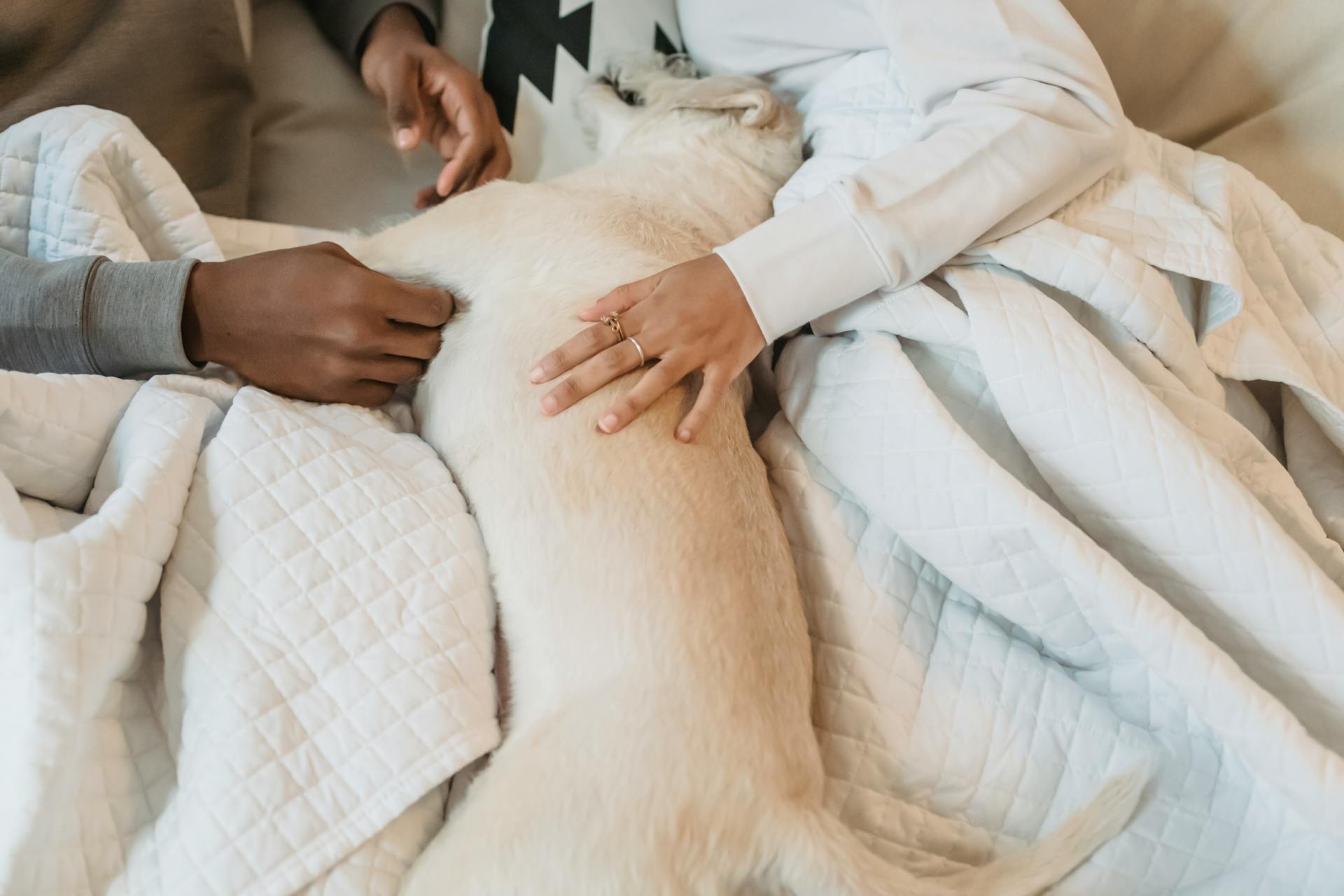
💡So imagine tracking your dog’s sleep – with just a glance at your phone?
That’s where Tractive’s Sleep Monitoring can come in handy.
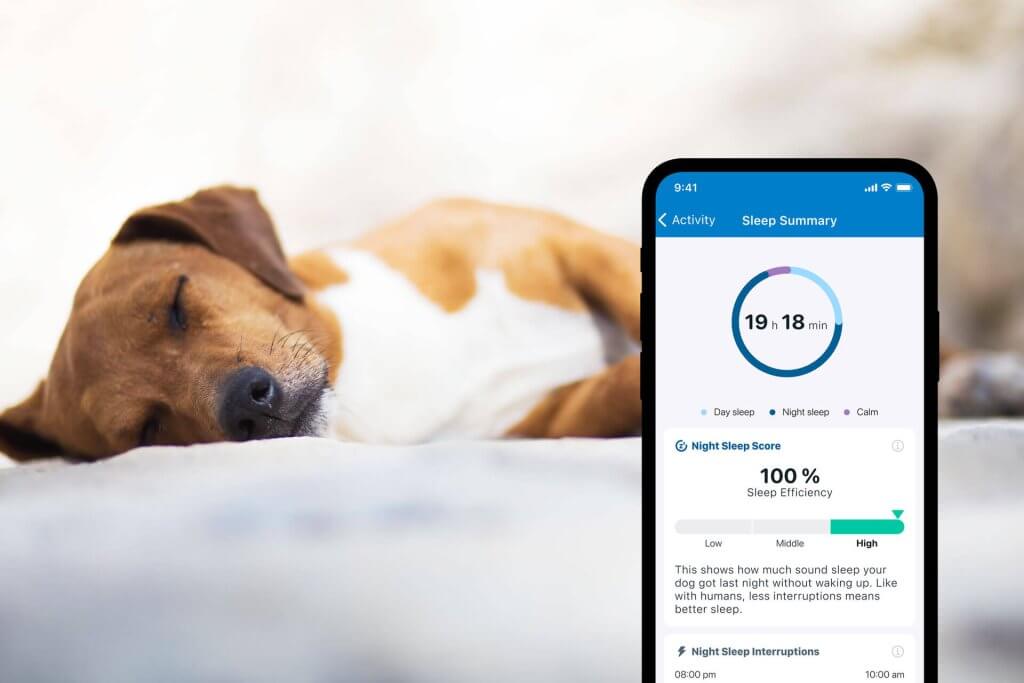
With its built-in motion detector, your trusty Tractive device picks up on your dog’s movements throughout they day – including when they’re asleep.
Which can help you figure out:
- What’s a normal amount of sleep for your dog
- How much quality sleep your buddy’s gotten
- How many times their sleep was disturbed
And most importantly: whether there’s an abnormal change in how much they’re sleeping. (Whether more or less than usual.)
⚠️ For example, if you’ve got a senior dog at home, a change in their sleep cycles can hint at serious degenerative conditions – like canine cognitive dysfunction syndrome.6
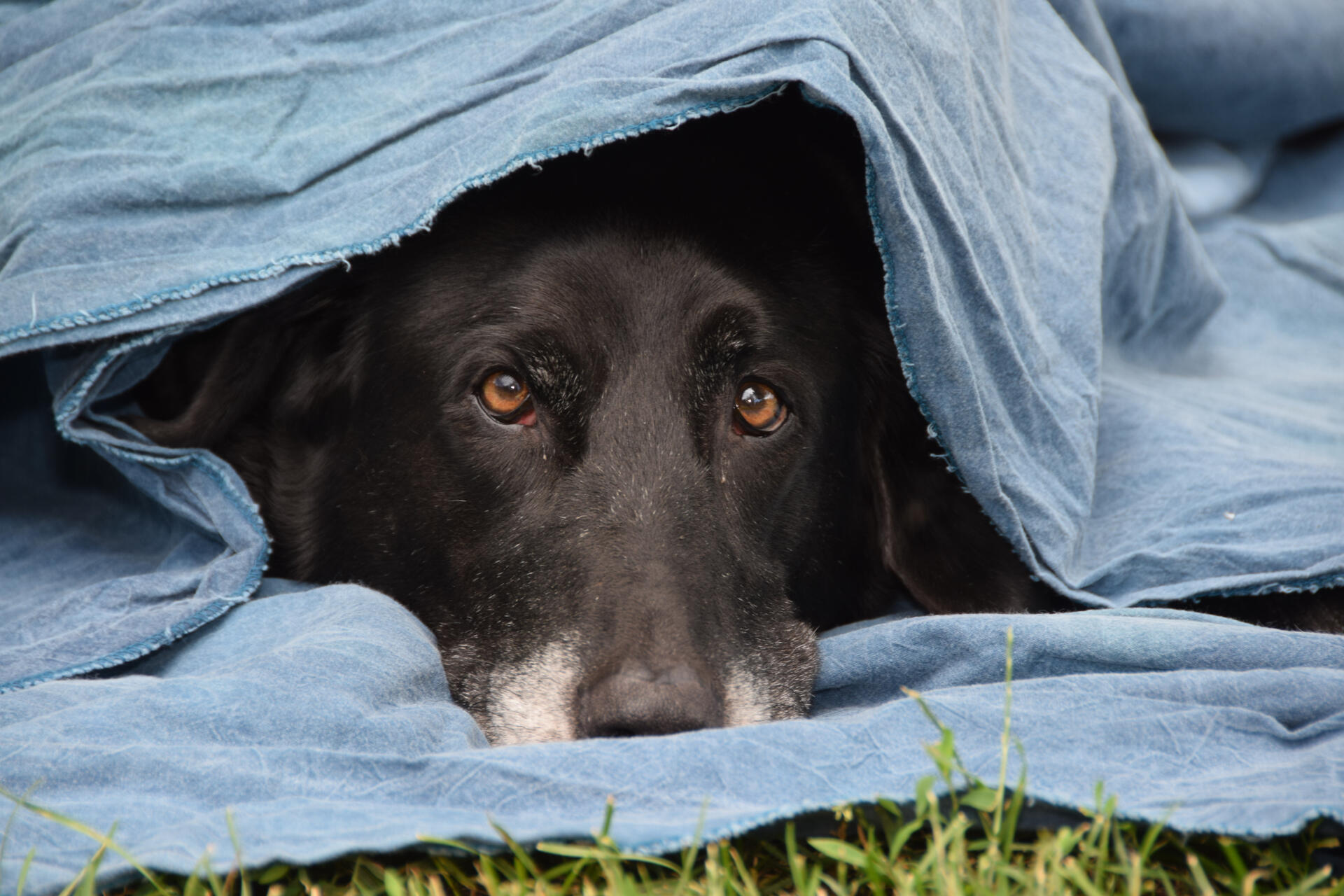
- But if you’re tracking your dog’s sleep, you now have actionable data at hand – so you can have a more productive conversation with your vet.
- Plus, now you can more quickly spot a change in your dog’s sleep patterns – and get them to a vet right away for a checkup. (Helping you avoid an expensive medical bill down the line.)
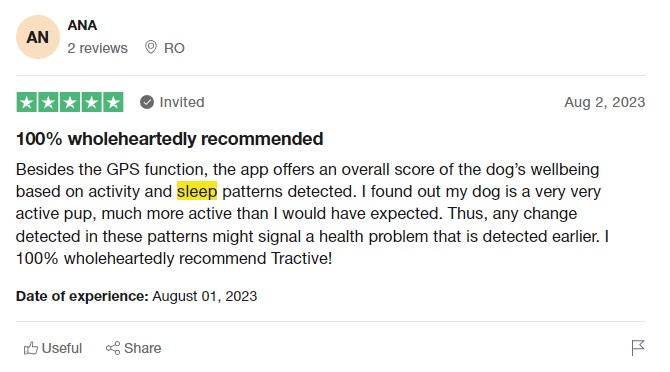
💡Wondering how your Tractive device’s battery will fare tracking your dog’s sleep all night?
Not to fear – you can massively cut down on battery usage by connecting your Tractive device to a trusted network, like you home WiFi. Aka, set up a Power-Saving Zone at home.
And with a Tractive Base Station, you can set up a Power-Saving Zone wherever you go!
Dog sleeping in bed: Pros, cons & how to decide what’s best
Now ultimately, you’re the one who gets to choose where your dog sleeps at night – whether it’s tucked in bed with you or in their own little bed elsewhere.
Because if you choose to have a dog sleeping in bed with you, you’re likely to feel warmer, safer, and less anxious.
But on the other hand, there’s always the possibility your dog might disturb your sleep, infect your sheets with ticks and diseases, get sick in bed, or territorial about their spot.
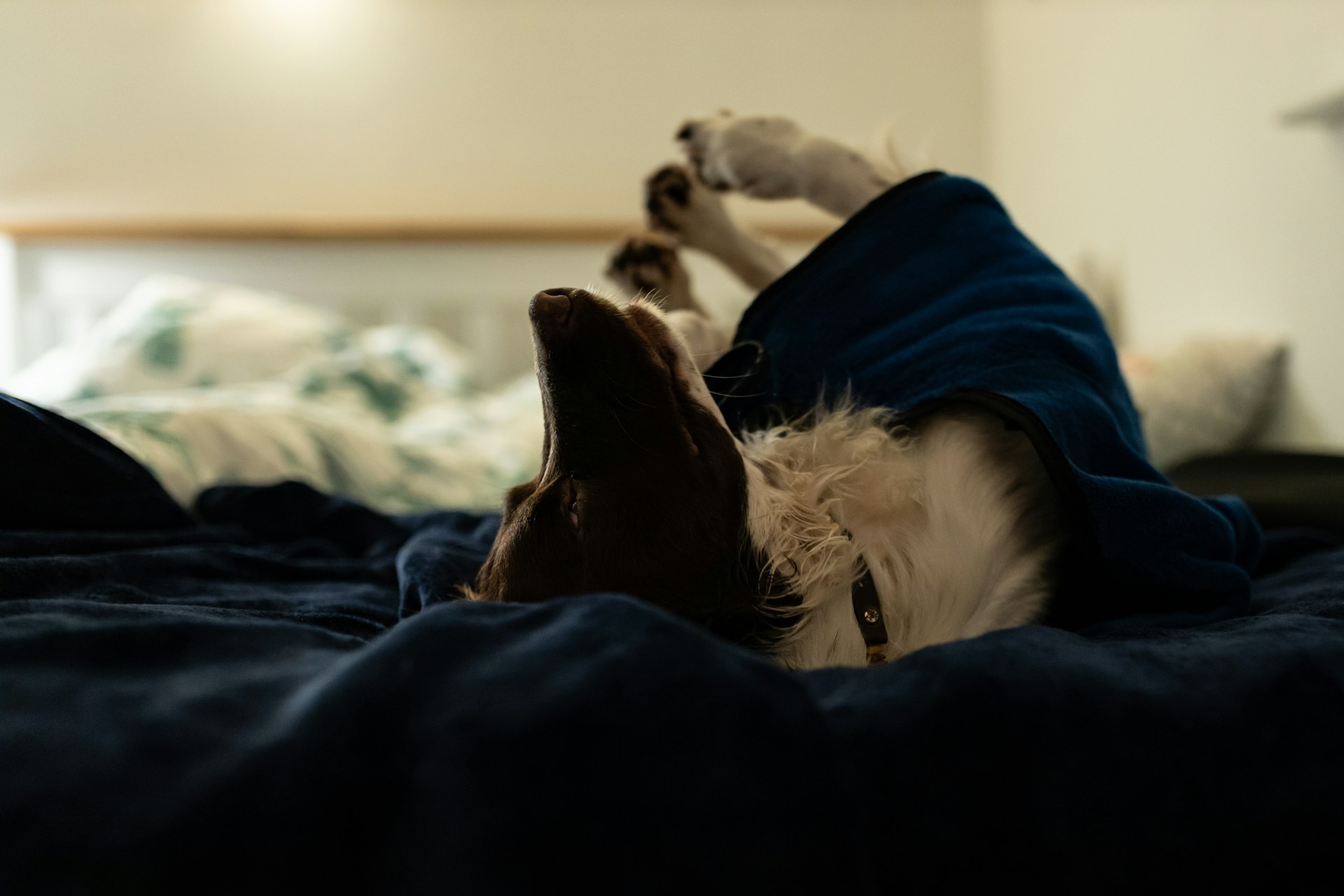
Which is where it makes sense to:
- Keep track of where your dog’s off wandering. (Both indoors and outdoors.) This can help you figure out if your dog’s likely to pick up something infectious from your neighbors’ garden or from your very own attic or basement.
- Monitor how well your dog is sleeping. So you can catch on to a sleep disturbance early on and adjust your environment – or get them a preventive checkup in case you notice an abnormal change in their sleep patterns.
And the best part? Your trusty Tractive GPS has everything you need for monitoring both your dog’s location, health, and well-being – all in one device:
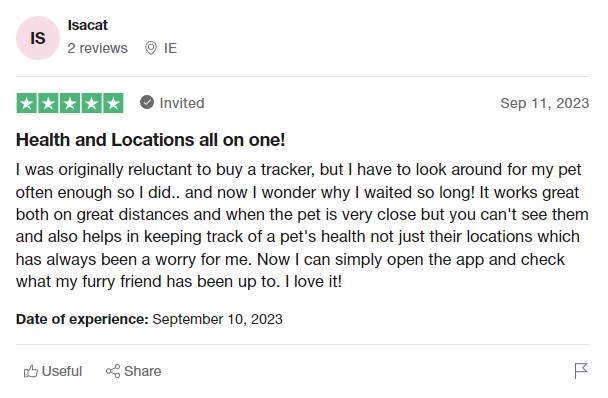

Stay on top of your dog’s wellness
See how they’re doing at a glance with Wellness Score. Set goals. Compare with dogs like yours. Monitor sleep. Detect issues and keep them healthy.
No matter which sleeping arrangement you choose, you and your dog can still enjoy a close bond. The most important thing is that everyone is happy and healthy, and gets a good night’s sleep!
Still curious why dogs love to sleep with us in bed? Check out this video by Animal Wised:
And if you’ve liked this post, share it with a friend or a loved one – and let’s help build a safer, kinder world for our furry friends together.




